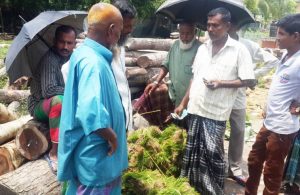Healthy Rice Seedlings for Improved Livelihoods

Low-cost interventions to promote healthy rice seedlings scaled-out in Bangladesh
Rice nurseries are an important, but often underappreciated, component of a successful agronomic production cycle. How a rice crop is managed in its early stages influences performance and yield later. For example, it is very important to transplant healthy seedlings at an appropriate time to get optimum yield. However, in the absence of proper nursery management and supervision, many farmers obtain suboptimal yields.
As a common practice in South Asia, rice seedlings are grown in nurseries on flat seedbeds, and are then transplanted manually into puddled soil. In Bangladesh, transplanted rice covers around 85 percent of the total rice area. In the aman (wet) season, farmers start preparing rice nurseries after the onset of the monsoon in mid-June and usually transplant more than 30-day old seedlings from mid-July to August. While in the boro (dry) season, farmers start preparing rice nurseries in late-November and usually transplant more than 40-day old seedlings from early-January to early-February.
Many Bangladeshi farmers are knowledge-, labor- or resource-constrained and do not follow optimal nursery management practices. Farmers practice less productive methods, such as not making drainage channels in seedbeds, not removing half-filled or empty seeds, not treating seeds with chemicals to reduce the risk of insect and disease infestation at the later stages of crop growth, using unnecessarily large volumes of seeds, not applying farmyard manure and or optimal doses of fertilizers while preparing land for seedbeds, and transplanting old or thin seedlings.
The use of old and unhealthy seedlings has a huge economic cost. Studies have shown that the use of old and unhealthy seedlings can cause more than 10 percent yield loss in rice. This means that scaling the adoption of young and healthy seedlings in at least half of Bangladesh’s 11.7 million hectares rice area could produce an additional 2.5 million tons of paddy per year, which would contribute an additional US$ 680 million to the national economy, and potentially improving the food security of millions of poor Bangladeshis. This would make a huge positive socioeconomic impact for the country and it is achievable by rolling-out some simple interventions.
A variety of improved rice nursery management options are available for Bangladeshi farmers, including seed treatment before sowing (to reduce the potential for diseases), adopting optimal sowing dates for different cultivars in different environments, planting in the correct seed densities, using balanced organic and inorganic fertilizers, and following optimal transplanting age and density. The latter is particularly important for avoiding transplanting shock, which in addition to causing yield losses can also result in delayed crop maturity and harvests, and can further delay the sowing of the subsequent boro crop, in the case of monsoon aman rice. However, majority of farmers are not using these improved options because of knwoledge gap or lack of resources.

A trader sells his rice seedlings at a ‘haat bazaar’ or open air-market in Bangladesh. In Faridpur District, approximately 10 such markets are convened in the aman season where 15-20 traders, coming from different locations, buy and sell seedlings. Photo: Humnath Bhandari/IRRI
The Cereal Systems Initiative for South Asia (CSISA) is playing a catalytic role to scale out healthy rice seedlings in the Feed the Future Zone in Bangladesh. Working collaboratively with the Department Agricultural Extension, NGOs, development projects, input dealers, farmer groups and lead farmers, CSISA has focused on a two-pronged approach to scale-out the use of healthy rice seedlings. First, targeting individual rice farmers to produce and use healthy rice seedlings through better nursery management practices. Second, targeting rice nursery entrepreneurs for large-scale production and supply of healthy seedlings in the market alongside income generation through rural enterprise creation.
A diagnostic survey has indicated significant potential to promote improved rice nurseries management practices for production and use of healthy rice seedlings in FtF zone, especially when these messages are deployed at a large scale by development partners and livelihood initiatives, and by linking entrepreneurs to markets. However, the interventions cannot be scaled-out in the tidal flood prone areas of Barisal Hub and the submergence prone areas of Faridpur Hub.
Through mass-media campaigns such as showing a video and distributing leaflets to farmers, training lead farmers and farmer groups on ideal rice nursery technologies, training rice nursery entrepreneurs and input dealers on production and marketing of healthy seedlings, and conducting training of trainers workshops for extension agents of government and NGO, CSISA has supported large-scale awareness and adoption of healthy rice seedlings among farmers across Faridpur, Jessore, and Barisal Hubs in this year. In 2016 aman season alone, CSISA, working together with partners, showed a video to more than 23,200 farmers, distributed leaflets to 650 farmers, initiated eight new community-based nurseries, trained 20 rice nursery entrepreneurs, and conducted training of traniers workshop to 80 extension agents. These activities will continue and expand in coming seasons.
This article is authored by Humnath Bhandari, Agricultural Economist, International Rice Research Institute, Bangladesh.
Tags: Bangladesh, Feed the Future
